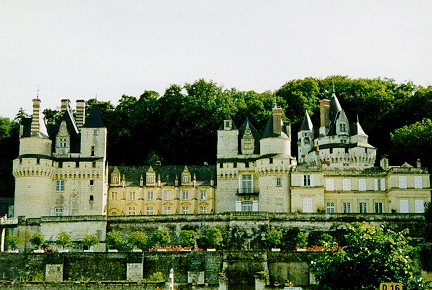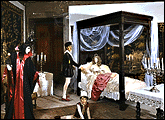Le Chateau d'Usse
The Castle Of Sleeping Beauty
Web Site by Katie Mayer and Jaclyn Morrissey
Glossary of lesser known terms at bottom of screen.

This castle is known as the castle of dreams.


Location:
It is located in the famous Loire Valley at the edge of the Forest of Chinon. It overlooks the Loire and Indre River valleys. Just a two hour car ride from Paris, the best view of the entire magnificent castle is either from the bridge right before the castle or from the banks of the Loire itself.

Occupants:
The castle was built for the Buiel family in the second half of the 15th century. This was a family that had distinguished itself in The Hundred Years War and now was seeking a home befitting there new rank in society. The family did not stay long however for Antoine De Buiel, the husband of Louis VII’s daughter, sold the castle in 1485 to Charles Espinay who set about making many improvements and is known for having the famous chapel built on the grounds. The Espinays served as chamberlains to many of the royalty and kings of their time. This castle has changed hands many times. From 1807 to 1813, the Duchess of Duras, a friend of Francois Rene de Chateaubriand, lived at Usse. In 1885 the Count de Blacas bought the home. His descendants still live and make a home there today. The Marquis de Blacas, who is the grandson of the man who began the Egypt Department at the Louvre, resides there at this time.

History:

Compared to the other castles of the Loire Valley, the Usse has a very tranquil history. It was built on the foundation of an 11th century fortress. Because of its combination of beauty and fortress like appearance, it is believed that Perrault wrote his famous story, “Sleeping Beauty,” based on Usse. Of the structure Perrault wrote, “Chateau de la Belle au bois dormant.” This is one of eleven fairytales he wrote in a collection called, “Les Contes de ma mere l’Oye.”
The castle played another part in history when it stood as a model for the design of Disney’s famous Cinderella’s Castle in Disney World. Designers used this and other castles of the Loire Valley. Looking at a picture of the two, it is easy to see the similarities between the them.

The Building Itself:

The Buiel family began the construction in the mid 1400's. It was built with many roofs, turrets, dormer windows and chimneys. It’s blue roofs and white stone walls make it especially beautiful. Also, the fact that it sets against a green forested backdrop of the Forest of Chinon. Outside, the walls are sturdy and fortified. However, inside is much more open with a courtyard and gardens. The entire building stands above terraced gardens with a beautiful view of the valley below.
Gardens and Courtyards:

The courtyard has three separate areas which are inspired by different architectural designs. To the east is Gothic, the west is Renaissance and the south is Gothic and Classical. The area to the north was torn down during the 17th century to allow the extraordinary views to be unobstructed. The garden area is well known and was designed by La Notre. It is known as the King’s Gardens and it includes a spiral staircase.

There is also a path around the battlements. Along this path are glassed in rooms depicting scenes from the story of “Sleeping Beauty.” Wax figures and a great deal of detail are used in these displays to convey not only the story but the time of it origin as well.
Inside the Castle:

Inside there are many grand rooms and halls with a great deal of antiques and furnishings. On some of the ceilings are trump l’oeil paintings designed to fool the eye. There is also a display of tapestries, some done by Teniers the Younger.This is found on the ground floor and an exhibit of paintings is located on the first floor. There is also some of Charles Perrault’s original manuscripts on display. The Guard Room has a collection of Saracen arms which has been collected by the Blacas family.
Like most castles of the region, Usse has a Sall du Roi or king’s room. It is richly furnished and meant to be used by a traveling king should one stop by. There are also bedchambers known as the Louis XIV, Louis XV and Louis XVI. None of these have ever been used by these royals or by any other. Still the royal apartments are completed with 18th century furniture and wax models depicting the clothes and customs of the times.

The Chapel:

One of the best known structures at Usse is the chapel located on the edge of the forest. It was built by the Espinays from 1523-1535. It is a renowned example of Gothic to Renaissance architecture. It is still much the same as when it was built. It has a sculpted facade with shells, rose windows and arabesques on the outside walls. Throughout the chapel are found the letters C and L for Charles d’Espinay and his wife, Lucrece de Pons. Also inside, there is an enameled sculpture of the Virgin Mary done by Luca Dello Robbia. For a large sum of money, this chapel can be rented for a fairytale wedding all your own.

Glossary of Terms
arabesque
(n.) 1. Fine Arts. a sinuous, spiraling, undulating, or serpentine line or linear motif. 2. any ornament or ornamental object, as a rug or mosaic, in which flowers, foliage, fruits, vases, animals, and figures are represented in a fancifully combined pattern.
battlement
(n.) 1. Often,"battlements."a parapet or cresting, originally defensive but later usually decorative, consisting of a regular alternation of merlons and crenels; crenelation. Also called"embattlement."
Chââteaubriand
(n.) 1. French author and statesman.
chamberlain
(n.) 1. an official charged with the management of the living quarters of a sovereign or member of the nobility. 2. an official who receives rents and revenues, as of a municipal corporation; treasurer. 3. the high steward or factor of a member of the nobility. 4. a high official of a royal court.
dormer
(n.) 1. Also called"dormer window."a vertical window in a projection built out from a sloping roof. 2. the entire projecting structure.
turret
(n.) 1. a small tower, usually one forming part of a larger structure. 2. a small tower at an angle of a building, as of a castle or fortress, frequently beginning some distance above the ground.
Rose Window:
Round window in a frame of heavy tracery radiating out like the spokes of a wheel, and containing stained glasses.
Saracen
(n.) 1. Hist. a member of any of the nomadic tribes on the Syrian borders of the Roman Empire. 2. (in later use) an Arab. 3. a Muslim, esp. in the period of the Crusades.

















